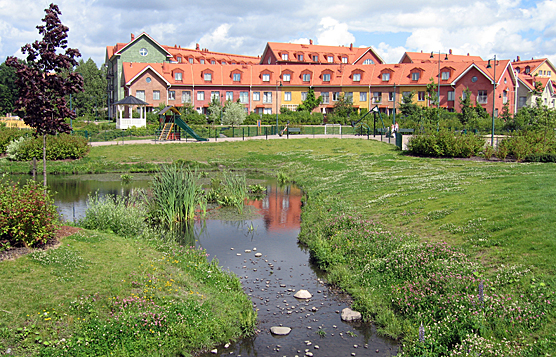
Rain and melt water is guided naturally, using wetlands and green areas in the Kartanonkoski residential area in Vantaa. The natural processing of stormwater is also a form of preparation for climate change. © Pirjo Ferin / SYKE
The Finnish Meteorological Institute and the Finnish Environment Institute aim to develop instructions for sustainable regional and urban planning, taking into consideration the mitigation of climate change and adaptation to the change. Spreading good practices to be used as part of the everyday work in urban planning is essential.
"There is plenty of research information available about the adaptation to climate change, but the information about how this affects practical city planning is not available in a compiled form for the planners", says researcher Athanasios Votsis from the Finnish Meteorological Institute. "We wish to produce visual and interactive instructions which are applicable to many kinds of sites and planning situations, to be used as help by the planners."
Planning must be anchored to local conditions
From the perspective of planning, the two great challenges brought by climate change are the increasingly common heat waves and flooding in bodies of water and areas on the shores. These challenges must be considered by all cities, whether in Finland or elsewhere in Europe. However, the extent of the effects in various regions remains uncertain. In Finland, the cold temperatures, snow, slipperiness, and darkness of winter create their own particular challenges.
"It is clear that climate change will affect different areas and countries in quite different ways. Planners must also consider any cultural and historical special features of the cities. Spatial planning must always respect the local conditions and try to find solutions that are the most beneficial for each area", Votsis points out.
Sustainable urban planning aims for a balance of ecological, financial, and social benefits. It must also look into the future and be able to anticipate the joint effects of changes.
Help from nature’s own solutions
Nature’s own solutions are often the best way to adapt to climate change. Green areas are saturated with water and they hold the water in them, while providing protection from extreme weather conditions, like strong winds and heat. In Finland, natural green areas are plentiful even in large cities.
"In addition to climate benefits, green areas provide refreshment and health benefits, while protecting the biodiversity of urban nature. These are all factors which often also create positive financial effects. For example, investing in green roofs or wetlands which balance out flooding may prove to save on costs later, when the negative effects of climate change are avoided"; Votsis says.
"Green areas do not need to be massive in size, but there should be a sufficient amount of them, spread out evenly throughout the city. That way, their positive effects for the city and its residents will be significant. A couple of wetlands in the newest residential areas is not enough", he points out.
Apartment prices may increase in areas with plenty of green areas or utilisation of renewable energy, for example. Therefore, it should be considered already in the planning phase how the solutions will affect the possibilities of people with low income to live in the area.
The city’s resources available for everyone
Climate emissions and the consumption of natural resources can also be reduced using spatial planning. Space can be reserved in connection with residential areas for shared food and energy production areas of the residents, for example. One good example of this are the communal garden areas found in many cities around Finland.
"Planners can provide residents with the possibility to utilise shared indoor or outdoor facilities or shared cars, for example. I understand that it is kind of nice for everyone to have their own sauna in their apartment, but why couldn’t cosy shared saunas and facilities be built to support the interaction of the residents?", Votsis says.
The saving of energy is promoted by planning residential areas to support the use of public transport and renewable energy solutions. Shared neighbourhood energy clusters can even produce electricity for the network and provide financial benefits.
Good practices spread from city to city
The instructions for sustainable spatial and urban planning are compiled together with cities. Turku and Hyvinkää are the pioneers helping in the creation of the instructions and, possibly, even the application of the instructions in their areas.
The aim is to organise workshops in several cities for planners and decision-makers at a later time. In addition to the workshops, training will be organised in cities participating in the Canemure project, for example.
"We don’t need to reinvent the wheel, as we can use all these good methods which already exist. It is essential to reach an understanding alongside the planning board about the solutions needed, and to systematically apply them to practice. Changing legislation may be a slow process, but applying and sharing good practices will often promote climate work faster", Votsis says.
Read more
Further information
- Head of unit Heikki Tuomenvirta, the Finnish Meteorological Institute, firstname.lastname@fmi.fi, tel. +358 50 574 6824